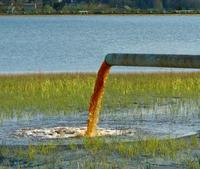-
UN report indicates Syrian army used chlorine in April attacks on rebel-held villages
The Organization for the Prohibition of Chemical Weapons (OPCW) said that a toxic chemical, probably chlorine, was used as a weapon to attack three Syrian villages in April. The agency investigators did not specify who had launched the chlorine attacks, but the full report, which so far has been shared only with governments, leaves little doubt that the Syrian government was responsible for the attacks.
-
-
Electric bugs harnessed to detect water pollution
Scientists have developed a low-cost device that could be used in developing countries to monitor the quality of drinking water in real time without costly lab equipment. The sensor contains bacteria that produce a small measurable electric current as they feed and grow. The researchers found that when the bacteria are disturbed by coming into contact with toxins in the water, the electric current drops, alerting to the presence of pollutants in the water.
-
-
Convergence of chemistry and biology raises concerns about designer toxins
The convergence of chemistry and biology is providing major benefits to humankind, particularly in health care, alternative energy sources, and in environmental control – and when combined with other advances, particularly in nanotechnology, it is also being exploited in developing improved defensive countermeasures against chemical and biological warfare agents. This convergence, however, has also raised concerns that biotechnology could be applied to the production of new toxic chemicals, bioregulators, and toxins. A new report from OPCW says that the potential for scaling up biological processes for large scale production of chemicals of concern is still limited, but biomediated processes might still be effective for producing weaponizable quantities of toxins which are lethal to humans in microgram or lower dosage.
-
-
OPCW says Syria has completed handover of chemical weapons, but some are skeptical
Syria handed over the remaining 100 tons of toxic material to the Organization for the Prohibition of Chemical Weapons (OPCW) last Monday. The final consignment, publicly delayed, consisted of about 8 percent of the total 1,300 tons that the country is believed to have possessed. Despite the celebratory mood, many in the West look at the Syrian and OPCW announcements skeptically due to conflicting information.
-
-
Engineered enzymes to neutralize deadly effects of chemical weapons
Researchers are a step closer to creating a prophylactic drug that would neutralize the deadly effects of the chemical weapons used in Syria and elsewhere. The researchers are trying to engineer enzymes — called bioscavengers — so they work more efficiently against chemical weapons.
-
-
Chemical pollution of European waters is worse than anticipated

Until now environmental authorities and parts of the scientific community have considered toxic chemicals to be rather a local problem affecting only a few bodies of water. A new study, however, reveals for the first time on a large scale the ecological risks emanating from chemical toxicants for several thousands of European aquatic systems. Chemical toxicity represents an ecological threat to almost half of all European bodies of water, and in approximately 15 percent of cases, the biota in freshwater systems may even be subject to acute mortality.
-
-
Smart coating could make oil-spill cleanup faster and more efficient
In the wake of recent off-shore oil spills, and with the growing popularity of “fracking” — in which water is used to release oil and gas from shale – there is a need for easy, quick ways to separate oil and water. Now, scientists have developed coatings that can do just that.
-
-
Federal oversight of ammonium nitrate exceedingly weak
A new Government Accountability Office(GAO) report found that the federal government has no way of fully knowing which chemical facilities stockammonium nitrate, a widely used fertilizer which was the cause of the explosion last year at a West, Texas fertilizer plan, which resulted in the death of fourteen people – and which was used by Timothy McVeigh in Oklahoma City twenty years ago. Poor data sharing with states, outdated federal policies, and numerous industry exemptions have contributed to a weak federal oversight. Without improved monitoring, regulators “will not know the extent to which dangerous conditions at some facilities may continue to exist,’’ the GAO report said.
-
-
New compound offers protection against chemical weapons
Researchers have discovered that some compounds called polyoxoniobates can degrade and decontaminate nerve agents such as the deadly sarin gas, and have other characteristics that may make them ideal for protective suits, masks or other clothing. The use of polyoxoniobates for this purpose had never before been demonstrated, scientists said, and the discovery could have important implications for both military and civilian protection. A UN report last year concluded that sarin gas was used in the conflict in Syria.
-
-
Mustard plants help detect use of chemical weapons
Making nations comply with the Chemical Weapons Convention requires that scientists can accurately detect the use of chemical warfare agents. Currently they carry out tests on soil from areas where use is suspected. Many nerve agents composed of organo-phosophorous compounds, however, leach from soil over time, removing the evidence of use and making verifying the deployment of chemical weapons like sarin, soman, and VX difficult. Researchers report that white mustard plants can help by allowing detection for up to forty-five days after the chemical weapons were used.
-
-
Western intelligence: Assad plans to retain residual chemical weapons capability
Israeli intelligence officials say the regime of President Bashar Assad in Syria may be concealing a small amount of the chemical weapons in its possession, while pretending that it is fully cooperating with the process to remove all chemical weapons from Syria. This assessment is similar to conclusions reached by the U.S. and U.K. intelligence communities in the past two weeks. The Israeli view is that the retention of chemicals by the Assad regime has to do with the ongoing fight against the rebels, and is not an indication that the regime is contemplating their use against Israel. A senior intelligence source also said that unlike the consensus in the intelligence community a year or two ago, the Israeli defense establishment no longer considers bringing down the regime in Damascus as necessarily positive for Israel.
-
-
One in ten American schoolchildren in school near risky chemical facility
One year after the fertilizer facility explosion in West, Texas, which destroyed and severely damaged nearby schools, nearly one in ten American schoolchildren live and study within one mile of a potentially dangerous chemical facility. A new study shows that 4.6 million children at nearly 10,000 schools across the country are within a mile of a facility which produces, uses, or stores significant quantities of hazardous chemicals identified by EPA as particularly risky to human health or the environment if they are spilled, released into the air, or are involved in an explosion or fire.
-
-
Identifying the most likely non-state chem-bio threats
New research finds that Jihadists pose the most likely chem-bio threat, but other actors also featured as top threats. Jihadist actors occupied seven of the top 10 spots in a qualitative analysis; nine of the top 10 in a quantitative analysis; and half of the top 10 in an elicitation analysis.
-
-
Israel: Assad used chemical weapons on 27 March in a Damascus neighborhood

President Bashar Assad’s military used chemical weapons two weeks ago in a neighborhood east of Damascus against opposition forces, a senior Israeli defense official said yesterday (Monday). Syrian rebels reported of two instances in which Assad’s forces used chemical weapons recently, both about two weeks ago and both in Damascus neighborhoods, and the Israeli confirmation was the first information provided by outside intelligence sources to back up the rebels’ claims.
-
-
Chemical plant security measure moves forward in the House
The House Homeland Security Committee and the House Energy and Commerce Committee are making progress on legislation meant to extend DHS’s Chemical Facility Anti-Terrorism Standardsprogram, which helps secure commercial chemical plants from terrorist attacks. Several attempts by the House Homeland Security Committee to extend the program have failed due to disagreements with the House Energy and Commerce Committee, which also oversees the matter.
-
- All
- Regional
- Water
- Biometrics
- Borders/Immig
- Business
- Cybersecurity
- Detection
- Disasters
- Government
- Infrastructure
- International
- Public health
- Public Safety
- Communication interoperabillity
- Emergency services
- Emergency medical services
- Fire
- First response
- IEDs
- Law Enforcement
- Law Enforcement Technology
- Military technology
- Nonlethal weapons
- Nuclear weapons
- Personal protection equipment
- Police
- Notification /alert systems
- Situational awareness
- Weapons systems
- Sci-Tech
- Sector Reports
- Surveillance
- Transportation
Advertising & Marketing: advertise@newswirepubs.com
Editorial: editor@newswirepubs.com
General: info@newswirepubs.com
2010-2011 © News Wire Publications, LLC News Wire Publications, LLC
220 Old Country Road | Suite 200 | Mineola | New York | 11501
Permissions and Policies
Editorial: editor@newswirepubs.com
General: info@newswirepubs.com
2010-2011 © News Wire Publications, LLC News Wire Publications, LLC
220 Old Country Road | Suite 200 | Mineola | New York | 11501
Permissions and Policies
